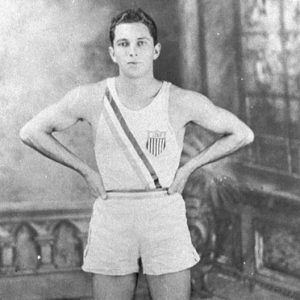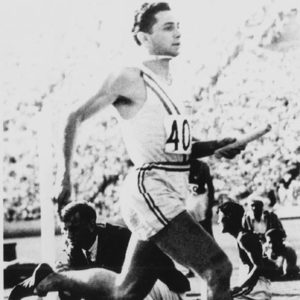calsfoundation@cals.org
Bill Carr (1909–1966)
William Arthur (Bill) Carr was the first Arkansan to win two gold medals in the same Olympic games, setting new records for track and field in the 1932 Los Angeles, California, Olympics. At the age of twenty-one, he set an Olympic record of 46.2 seconds in the 400-meter sprint, which stood until 1948, when it was tied. In 1954, he was named to Sports Illustrated’s All-Time Olympic Team.
Bill Carr was born in Pine Bluff (Jefferson County) on October 24, 1909, the younger of William L. and Ann Holmes Carr’s two sons. In the fall of 1925, Carr entered Pine Bluff High School, searching for an organized team sport that would accept him. At the strained height of 5’6″, if that, and an approximate weight of 125 pounds, he was too small for football or basketball. Instead, Carr tried out for the track team. While displaying some remarkable jumping skills, he sprained both ankles and was forced to drop out near the end of the season.
After coaxing from school officials, Carr, then a junior, returned to the track team for the 1927 season. At the state track meet held in Arkadelphia (Clark County) that spring, Carr gained national attention by performing a high jump of an astonishing and record-making 6′ ¾” and a long jump of 21’4″ (both of which secured wins for him), in addition to finishing a close second in both the 100- and 220-yard events. At a previous track meet in El Dorado (Union County), Carr had leaped 22’7″ in the long jump, clocked 22.3 seconds in the 220-yard sprint, and equaled a state record in the 100-yard sprint. These accomplishments earned him recognition as the premier track star in the nation by state and national sports writers.
Carr was persuaded by a Pine Bluff banker to attend Pennsylvania’s Mercersburg Preparatory Academy in the fall of 1927, in order to prepare for the academic challenges of an Ivy League education. While at Mercersburg, he became the state’s champion in the long jump and the 100- and 200-meter events. Carr was courted by the University of Pennsylvania (Penn) and entered the school in the fall of 1929.
Carr soon became a campus favorite and was elected president of his sophomore class. He also was awarded the “Golden Spoon” for being the most outstanding, all-around student at Penn. While at the university, Carr never lost the 400-meter sprint, which quickly became his specialty. The Penn 1,600-meter relay team, which Carr anchored, also never lost this event during his college years.
In 1932, the world record holder in the 400 meters was Ben Eastman of Stanford University, who boasted a time of 46.4 seconds (he also held the record for the 200 meters). The Olympic record for the 400-meter sprint was 47.6 seconds, set in the 1924 games by Eric H. Liddell, who was later portrayed in the Academy Award–winning film, Chariots of Fire. At the Intercollegiate Championships (the forerunner of the National Collegiate Athletic Association or NCAA) held at Berkeley, California, in July 1932, Carr competed against Eastman, beating him in the 400-meter sprint with a time of 47.0 seconds. Several weeks later at the Olympic trials at Palo Alto, Carr again beat the Californian with a time of 46.9 seconds to Eastman’s 47.1
On August 4, 1932, the world’s best 400-meter sprinters assembled at the newly constructed Los Angeles Coliseum for the Tenth World Olympiad. Carr won his semi-final heat with a time of 47.2 seconds, breaking Liddell’s record time. Eastman matched Liddell’s record in his semi-final heat. What the New York Times sports page pegged as the “400-meter race of the century” was now set in motion for the Depression-ridden country.
William Walters of South Africa, Alex Wilson of Canada, James Gordon of the United States, and George Golding of Australia competed against Carr and Eastman in the finals held on August 5, 1932. At the backstretch, Eastman led, with Carr running near his right shoulder. At the curve, Carr pulled even with Eastman; and just eighty meters from the finish, he pulled away and won nearly two meters ahead of Eastman. Both runners had smashed the Olympic record, but Carr had established a new world record of 46.2 seconds. Several days later, Carr earned his second gold medal by running the anchor leg on the 1,600-meter relay team, helping the U.S. team to set a new Olympic record of 3:08.2.
After the Olympics, Carr returned to a special awards ceremony in Pine Bluff, where he received a trophy for his Olympic feats. After the 1932 Olympics, he recorded a lackluster track performance during the 1933 spring season. Carr lost his chance at a comeback when he broke both his ankles and his pelvis in a car accident in March 1933. He never competed again after the accident.
Carr joined the U.S. Navy in World War II and served as a naval officer in the Pacific. Near the close of the war, he met his future wife, Rachel, in Shanghai, China. The couple moved to Japan, where Carr worked for several American insurance companies. In 1954, Carr was named to Sports Illustrated’s All-Time Olympic Team. In 1964, he was inducted into the Arkansas Sports Hall of Fame.
On January 14, 1966, Carr died from congestive heart failure in his sleep in Tokyo, Japan. He is buried in Pine Bluff’s Graceland Cemetery. Today, statues at Mercersburg Preparatory School and the University of Pennsylvania track stadium (Franklin Field) honor his athletic and academic career.
For additional information:
Bearden, Russell E. “Arkansas’ Double Gold Olympic Medalist: Willam ‘Bill’ Carr.” Jefferson County Historical Quarterly 12, no. 2 (1984): 18–28.
“Carr Makes His Name on the Track.” Olympic.org. https://www.olympic.org/news/carr-makes-his-name-on-the-track (accessed June 6, 2023).
William A. Carr Collection. Albert M. Swank Library. Mercersburg Academy, Mercersburg, Pennsylvania.
William Arthur Carr Collection. University Archives and Records Center. University of Pennsylvania, Philadelphia, Pennsylvania.
Russell E. Bearden
White Hall, Arkansas
This entry, originally published in Arkansas Biography: A Collection of Notable Lives, appears in the CALS Encyclopedia of Arkansas in an altered form. Arkansas Biography is available from the University of Arkansas Press.
 Early Twentieth Century, 1901 through 1940
Early Twentieth Century, 1901 through 1940 Recreation and Sports
Recreation and Sports William Carr
William Carr  William Carr
William Carr 




Comments
No comments on this entry yet.